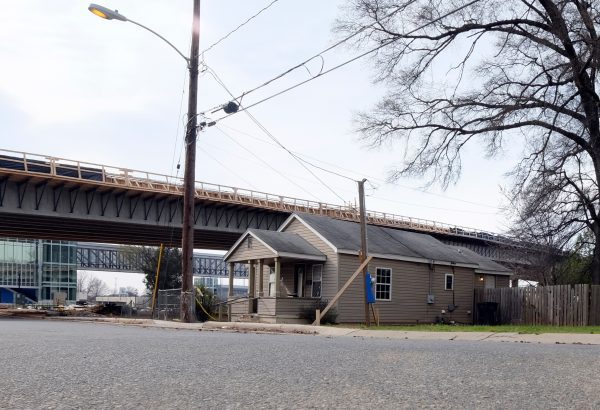Having the hard conversations: Gentrification and displacement in Charlotte

Our first Schul conversation this fall focused on gentrification and displacement – a conversation that’s necessary and often difficult. The discussion featured three panelists: one of our Gambrell Faculty Fellows, Dr. Kendra Jason; Charlotte attorney and community housing advocate, Ismaail Qaiyim; research economist at the US Census Bureau, Dr. Kate Pennington; and our Director of Regional Policy, Dr. Aaron Houck. Each brought extensive knowledge and expertise to the conversation and helped to frame many of the issues that make this conversation necessary and difficult.
The enormity of our need for housing that’s affordable to those with low and moderate incomes can paralyze us. At last estimation by the Institute, we are 23,022 units short in Charlotte-Mecklenburg for households earning 30% of the area median income or less (that’s about $17,700 a year for an individual or $26,500 for a family of 4). Additional households with higher incomes are also struggling with the cost of housing.
Because those estimated 23,022 abstract units represent the needs of real people (the 23,022 units are for households, so actually well over 23,022 people), we need to get comfortable with difficult conversations around both the simplicity of the issue, and also its complexity. Simply speaking, people need housing to survive and thrive. As we’ve noted before, housing policy is everything policy. And in simple market terms, it’s all about supply and demand.
But when the “rent eats first,” abstract and tidy economic principles don’t resonate. This is an uncomfortable and complex conversation about deceptively simple realities. And it touches on fundamental issues and disagreements: How do we balance growth and equity? To what extent should we trust the market vs. trying to intervene in some way? Should housing be viewed as a commodity, built for profit, or as a human right? Are these both/and or either/or considerations? Who decides?
There are also difficult conversations to be had about the complex realities of how our current system was built and the way we fix it. As was acknowledged in the conversation, U.S. housing policy was built in the U.S. around a bona fide and well-vetted risk model developed as a part of a dissertation at the University of Chicago. This abstraction of risk worked from a purely academic perspective. It protected the investment backed by the U.S. government – and it also ensured that 98% of the mortgages approved by our government between 1934 and 1968 went to White homeowners (See the book, The Color of Law).
Known now as “redlining,” this and other related policies set in motion a sea of spatial complexities that still protect and grow White wealth, while limiting the wealth and home values of Black, Indigenous, Latinx, and other families of color. Efforts to address the impact of early housing policy in the 1960s led to a series of legislative compromises, some that helped, all the while adding layers of complexity. These layers are not easy to undo.
One of those solutions (and compromises) was to engage the growing real estate development industry as a primary partner in solving emerging housing crises. There are volumes written on why this works or doesn’t and why it was a mistake or wasn’t. But it is a feature of our system. And, to name one of the challenges framed by our recent conversation, it speaks to the complexity of addressing the problem.
Building housing for any income and increasing housing density can eventually help to effectively reduce the cost of nearby housing. And as our panelist Dr. Pennington noted, it can reduce displacement due to legal evictions. But does it reduce rents enough to assist a renter making minimum wage? Probably not. Does it do it soon enough to meet the current demand? No. It doesn’t. This is a difficult conversation about the mismatch between current human need and the structures we’ve built to meet it that operate by definition on a different clock for a different, albeit related purpose.
At the Charlotte Urban Institute, we’ve historically grouped our work into the big buckets of the economy, the environment and social issues. Our first 40 years tilted more toward land use, planning, and the development and use of spatial indicators. When the Institute for Social Capital (now the Charlotte Regional Data Trust) joined us in 2011, our work turned toward more social challenges and solutions. With the hiring of Dr. Houck, our new Director of Regional Policy, we are reinvigorating our regional planning work.
This presents us an opportunity to sit with and respond to the cognitive dissonance, to simultaneously hold lived experience and seemingly disparate research from different disciplines and work to make sense of it. This isn’t an academic exercise, but a part of the path forward. While we have yet to specify the specific dynamics of this in the Charlotte region, growing research affirms that “filtering” is real – new development leads to more affordable units over time. The current expressed need is also real – as Dr. Jason, Dr. Janaka Lewis, and Dr. Tehia Starker-Glass’ work documents.
We heard this from panelists – there is a gap between what our community needs and what our current housing market is providing.
We will continue to explore the issues framed by last week’s conversation with Dr. Karen Chapple and local panelists at the Schul Forum on November 17. I hope you will join us. And we will continue to sit with the dissonance often created at the intersection of lived experience, the scholarship of human need and the scholarship of system dynamics – because that’s where a better understanding and solutions to our economic, environmental, and social challenges can be found.